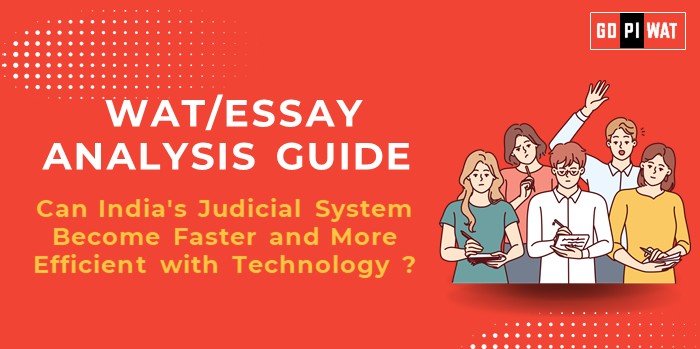📋 WAT/Essay Analysis Guide: Can India’s Judicial System Become Faster and More Efficient with Technology?
🌐 Understanding the Topic’s Importance
- 💡 Significance: India’s judicial backlog undermines justice delivery, impacting economic development and public trust. Incorporating technology into the judiciary aligns with global best practices and represents an essential reform.
📖 Effective Planning and Writing
⏳ Time Allocation:
- 📝 Planning: 5 minutes.
- ✍️ Writing: 20 minutes.
- 🔍 Review: 5 minutes.
📋 Structure:
- 📜 Introduction: 60 words.
- 📚 Body: 375 words.
- 🖋️ Conclusion: 65 words.
💡 Introduction Techniques
- 🔄 Contrast Approach: “While India leverages technology for UPI’s success, its judiciary lags behind with a backlog of 4.5 crore cases.”
- ✅ Solution-Based Approach: “AI-driven legal research and blockchain can be the twin pillars of India’s judicial transformation.”
📚 Structuring the Essay Body
🏆 Achievements:
- 📂 e-Courts Initiatives: Simplified case filing and access, reducing paperwork.
- 📹 Virtual Hearings: Reduced travel and time for litigants, especially during COVID-19.
⚠️ Challenges:
- 🌐 Internet Access: Lack of universal connectivity restricts rural participation.
- 🚧 Resistance to Technology: Some judiciary members are hesitant to adopt new tools.
🚀 Future Outlook:
- 🤖 AI Integration: For faster judgment drafting and legal research.
- 🔗 Blockchain Adoption: Ensuring tamper-proof evidence and secure digital case records.
📝 Concluding Effectively
⚖️ Balanced Conclusion:
“Technology holds immense potential for India’s judiciary, but inclusive policies and robust cybersecurity are prerequisites for success.”
🌏 Global Perspective Conclusion:
“India’s judicial digitization journey can mirror Estonia’s, provided challenges like rural connectivity are addressed.”
🔍 Analyzing Successes and Shortcomings
- 🏅 Successes: Increased e-filing adoption and reduced physical paperwork.
- 🚫 Shortcomings: Digital divide and cybersecurity vulnerabilities.
- 🌍 Global Context: Estonia and Singapore as benchmarks for success.
📈 Recommendations for Sustainable Progress
- 🌐 Expand BharatNet for rural court connectivity.
- 📚 Implement judicial tech training for personnel.
- 🔐 Strengthen cybersecurity frameworks to safeguard sensitive data.
✍️ Sample Short Essays
- ⚖️ Balanced Perspective: “India’s judicial backlog demands immediate attention. Technology, through AI and blockchain, can streamline processes and improve efficiency. However, bridging the digital divide and ensuring cybersecurity are critical for success.”
- ✅ Solution-Oriented: “To achieve faster judicial processes, India must integrate AI-driven tools for case analysis and blockchain for secure record-keeping. These changes can make justice delivery accessible and efficient.”
- 🌏 Global Comparison: “India can emulate Estonia’s digital judiciary model by investing in infrastructure and overcoming adoption barriers, paving the way for a robust, tech-enabled legal system.”


